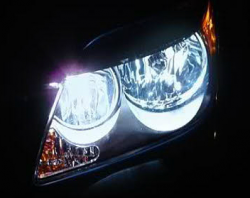
— Using Halogen headlights in your car might not be the great idea you thought it could be, at least according to research performed by AAA.
AAA tested three types of headlights: halogen, LED and HID, or "high intensity discharge" headlights. Researchers measured the distances that headlights illuminate non-reflective objects and found the results disappointing, regardless whether the high-beams or low-beams were activated.
The big finding from the research concerns halogen headlights, found in 80 percent of cars on the roads. Researchers discovered the halogen lights can fail to safely illuminate unlit roads (no overhead lighting) when traveling at speeds as low as 40 mph.
Who Wins the Battle of High Beams?
The high-beam setting on halogen headlights did provide a 28 percent improvement in sight distances, at least at the testing facility. However, researchers are concerned real-world conditions could mean the headlights, even on high-beam, would provide enough light only up to 48 mph.
To make matters worst, a survey conducted by AAA found only a third of U.S. drivers switched to high-beams when they should have.
Best Headlights for the Darkest Roads
Tests conducted on more advanced LED and HID headlights found large improvements over halogen lights. Both LED and HID headlights lit-up dark roads 25 percent further than halogen lights. LED and HID headlights while using the high-beam setting showed drastic improvements over using the low-beam setting, with lighting distances up to 500 feet, equal to 55 mph.
However, that's still 60 percent less than provided by daylight.
Why Basic Maintenance Matters
Additional testing determined the importance of cleaning or restoring the lens covers of the headlights. The coating used on the plastic lens can cloud after five years and cause light to scatter, causing deceased visibility to the driver and a glare to oncoming drivers. AAA recommends the lenses be maintained and restored yearly because the process can double the light intensity and reduce glare by 60 percent.
As for choosing headlights, American drivers are limited by federal rules that regulate the light output and intensity for all vehicles sold in the U.S. To drive at night using the best lights to illuminate the darkness, American drivers will need to drive European vehicles on European roadways, at least until the U.S. government gets out of the dark about the subject.




